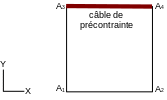1. Description#
1.1. Geometry#
The concrete plate is formed by a square with an edge length \(L\mathrm{=}\mathrm{0,9}m\) and a thickness \(e\mathrm{=}\mathrm{0,6}m\). The four vertices of the plate are named \({A}_{1}\), \({A}_{2}\), \({A}_{3}\), and \({A}_{4}\).
A cable, located on segment \(\mathrm{[}{A}_{3}{A}_{4}\mathrm{]}\), crosses the plate horizontally, without eccentricity in thickness. The cross-sectional area of the cable is \({S}_{a}\mathrm{=}{1.10}^{\mathrm{-}4}{m}^{2}\).

Figure 1.1-1: Geometry
1.2. Material properties#
The plate is reinforced concrete and the cable is steel. The properties of reinforced concrete result from the homogenization of the properties of concrete and the properties of the reinforcements using the DEFI_GLRC command.
Material |
Concrete |
Reinforcements |
Cable steel |
Young’s module |
\({E}_{b}\mathrm{=}\mathrm{3,57}{.10}^{10}\mathit{Pa}\) |
|
|
Poisson’s ratio |
\({\nu }_{b}\mathrm{=}0.2\) |
|
|
Density |
\({m}_{b}\mathrm{=}2500\mathit{kg}\mathrm{/}{m}^{3}\) |
|
|
Table 1.2-1: Material properties.
1.3. Boundary conditions and loads#
The segments \(\mathrm{[}{A}_{1}{A}_{2}\mathrm{]}\) and \(\mathrm{[}{A}_{1}{A}_{3}\mathrm{]}\) are respectively blocked in the direction \(Y\) and the direction \(X\). For its part, segment \(\mathrm{[}{A}_{2}{A}_{4}\mathrm{]}\) is locked in the direction \(Z\) as well as in rotation around the three axes.
Charging is applied in two steps. A first quasistatic calculation makes it possible to pre-stress the cable to a tension \(T\mathrm{=}\mathrm{2,0}{.10}^{5}N\). Then a uniform pressure oriented positively in direction \(\mathrm{-}Z\) is applied to the complete surface of the plate. Its maximum amplitude is \({P}_{\mathit{max}}\mathrm{=}\mathrm{0,15}\mathit{MPa}\), and it is associated with a ramp ranging from \(0\) to \(1\) between the times \({t}_{\mathit{initial}}\mathrm{=}\mathrm{0s}\) and \({t}_{\mathit{final}}\mathrm{=}\mathrm{0.004s}\).